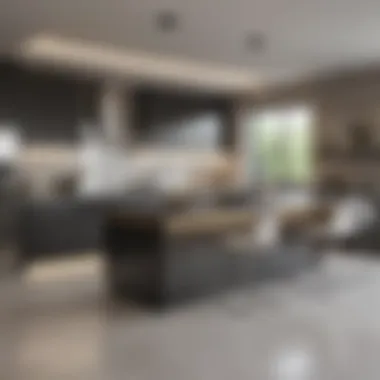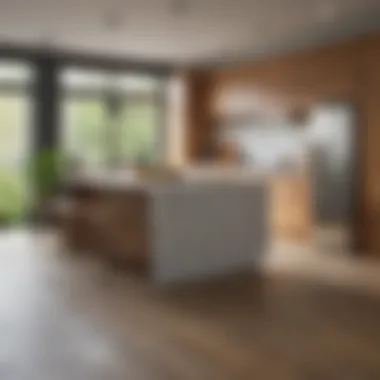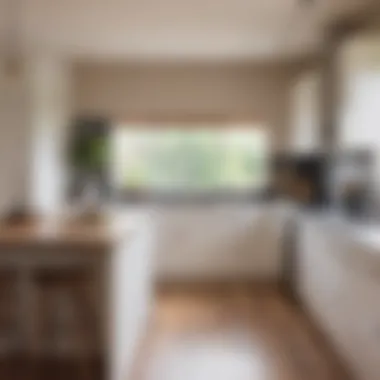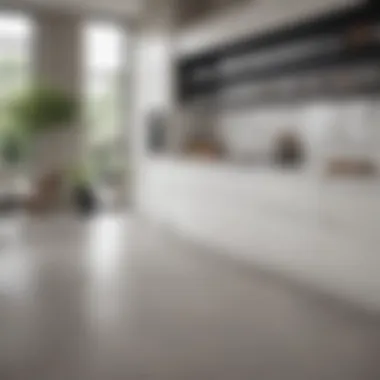Mastering Modern Kitchen Renovations: Essential Insights


Intro
When embarking on the journey of kitchen renovation, the process can feel as overwhelming as trying to put together a jigsaw puzzle without the picture on the box. Homeowners often juggle myriad decisions—everything from layout functionality to aesthetic details. This guide aims to distill the complexities of modern kitchen renovations into digestible insights, helping you steer through the design principles, material choices, budgeting, and sustainability trends that are imperative in today’s kitchen landscape.
As kitchens evolve from mere cooking spaces to multifunctional areas for family gatherings, work-from-home setups, and culinary creativity, knowing the key design trends can dramatically shape your renovation experience. The challenge lies not just in the practicality of the space but also in merging taste with innovation. This narrative invites homeowners and designers to explore contemporary ideas that exude both charm and efficiency.
With that in mind, let’s dive into the realm of Furniture Design Trends, an essential pillar in creating a cohesive and stylish kitchen.
Understanding the Modern Kitchen Concept
In today’s rapidly evolving world, the kitchen is no longer a mere cooking space; it’s a dynamic area that reflects personal style and meets practical needs. Understanding the modern kitchen concept is essential for any renovation endeavor, as it involves both aesthetic considerations and functional attributes. This section emphasizes how a clear grasp of modern principles can elevate your kitchen from pure functionality to a seamless blend of comfort, style, and utility.
Defining Modern Aesthetics
Modern aesthetics embrace simplicity and elegance while rejecting excessive ornamentation. When we talk about defining modern aesthetics in the kitchen, we are essentially discussing a design philosophy that prioritizes clean lines, open spaces, and a curated selection of materials. One might argue that less is more, and this is aptly demonstrated in modern kitchens, where clutter-free environments are cultivated to create a calming yet sophisticated ambiance.
Key elements to consider in modern aesthetics:
- Color Palette: Neutral tones such as gray, black, and white reign supreme, providing a backdrop that allows other design choices to shine. A splash of bold color can also be introduced for contrast, but it’s often done sparingly.
- Materials: The use of natural materials such as wood, stone, and metal speaks to a modern aesthetic that values authenticity and durability.
- Open Spaces: A move towards open floor plans helps to enhance the flow of the kitchen, integrating it with the living or dining areas while creating an inviting atmosphere.
Instead of standard cabinetry, consider open shelving which can showcase dinnerware and add a personal touch. Likewise, the incorporation of a statement light fixture can serve not only as a source of illumination but also as a piece of art, reflecting the homeowner’s personality.
"A kitchen should feel personal, yet orderly. The colors and materials should evoke feelings of warmth while maintaining that fresh, modern edge."
The Role of Functionality in Design
While aesthetics are important, they can easily fall flat without robust functionality. The role of functionality cannot be overstated in the modern kitchen design—it is the backbone upon which delightful culinary experiences are built. A kitchen that looks lovely but lacks adequate storage space or workflow efficiency can quickly become a source of frustration.
To ensure that your kitchen serves its purpose without compromising on style, consider the following functional elements:
- Work Zones: Define specific areas for cooking, cleaning, and prepping. This helps streamline activities and reduces the chaos during meal preparation.
- Storage Solutions: Clever storage options, such as pull-out drawers or lazy Susans, optimize space while maintaining an organized feel. By minimizing clutter, you allow the aesthetic aspects of your kitchen to shine.
- Ergonomics: Think about comfort. Designs that are mindful of height and reach can make a significant difference in usability.
Furthermore, technological integration plays a vital role in enhancing functionality. For instance, smart appliances can facilitate cooking and efficiency, while energy-efficient options promote sustainability without sacrificing performance.
Key Elements of Modern Kitchen Design
Designing a modern kitchen goes beyond selecting the latest trends; it involves strategically balancing aesthetics and functionality within the space. Key elements in modern kitchen design are crucial not just for visual appeal, but also for enhancing usability. A well-thought-out kitchen design takes into account color schemes, lighting, cabinetry styles, and several other aspects, making sure that homeowners can cook, eat, and gather in a space that feels cohesive and stylish.
Color Schemes: Trends and Choices
When tackling modern kitchen renovations, color schemes can make or break the vibe. A popular trend is to use a neutral palette with pops of color. For instance, a soft gray or off-white can serve as a backdrop, while a vibrant blue backsplash might draw the eye without overwhelming the senses. Colors like deep greens or navy add sophistication, especially when paired with natural wood tones.
Also, consider how the color interacts with light. A dark color in a small kitchen may make it feel cramped. Conversely, bright colors can illuminate a larger space, creating an inviting atmosphere. Choosing the right color is a way to foster energy or tranquility, making it a decision that is both aesthetic and psychological.
"The right colors set the mood and can transform your cooking space into something magical."
Lighting Solutions: Aesthetic and Practical
Lighting is a double-edged sword in a kitchen. It’s not just about shining light where it’s needed; it should be about creating atmosphere. Incorporating layered lighting strategies—ambient, task, and accent—can elevate a kitchen’s look and functionality.
- Ambient Lighting: This is the broad illumination throughout the kitchen. Pendant lights over the island or recessed lights can provide this function.
- Task Lighting: Under-cabinet lighting enables precise actions like chopping or reading recipes. Here, functionality reigns supreme, ensuring kitchen tasks are done with ease.
- Accent Lighting: This is to highlight design features or create focal points, such as in a glass cabinet or behind an art piece.
By striking a balance between these three types, you can achieve an inviting, multi-functional cooking space that is both beautiful and practical.
Cabinetry Styles: Minimalism vs. Functionality
Cabinetry choices often reflect personal style and practical needs. Minimalism has surged in popularity, with flat-panel doors and a clutter-free aesthetic becoming a hallmark of modern design. However, it's vital to look beyond aesthetic appeal and consider functionality.


Consider these points when choosing cabinetry styles:
- Storage Space: Do you have enough room for all your kitchen essentials? Minimalist cabinets are lovely, but if they lack storage options, they can be counterproductive.
- Materials: Wood offers warmth, while laminates provide durability. Opt for materials that fit your lifestyle; for instance, handle-less cabinets lend a sleek look but may not be the best choice for families with children.
- Color and Finish: High-gloss designs reflect light and create a sense of space, while matte finishes add a sophisticated touch without the glare.
Material Selection in Kitchen Renovations
When it comes to kitchen renovations, the choice of materials can make or break the entire project. Selecting the right materials goes beyond mere aesthetics—it's about longevity, maintenance, and how these elements interact with daily kitchen activities. Whether you’re a homeowner revamping your cooking space or a designer working on a client’s project, understanding material selection is key.
Material selection influences several critical dimensions of kitchen design:
- Durability: Kitchens are high-traffic areas subject to spills, heat, and wear and tear. Choosing materials that can withstand such conditions is vital. For instance, granite or quartz for countertops is often favored for their resistance to scratching and heat.
- Safety: Certain materials can be more slip-resistant or easier to clean, which is especially important in family households where children run around. Non-porous surfaces can also mitigate the risk of harboring bacteria, crucial for food prep spaces.
- Aesthetic Appeal: The overall ambiance and visual coherence of your kitchen are directly influenced by the materials used. Matching countertops, cabinets, and flooring creates a unified look.
- Cost and Maintenance: Some materials may require more upkeep and expense over time. Understanding the initial investment versus long-term care can help in making a smarter financial choice.
Moving forward, let’s break down specific materials within the kitchen that warrant thoughtful consideration.
Countertops: Durability and Style
Countertops serve not just as functional workspaces but as the kitchen's focal point. Thus, durability and style are paramount.
- **Granite: ** A timeless option known for its natural beauty and durability. It's resistant to heat and scratches but requires periodic sealing to maintain its integrity.
- Quartz: An engineered stone that combines a variety of materials, offering endless color choices and patterns. It's non-porous, making it a breeze to clean while being highly durable against stains.
- Butcher Block: This option adds warmth to kitchen spaces, ideal for those who love to cook. However, it's essential to maintain and oil the wood to prevent damage from moisture and heat.
Whichever material you prefer, ensure it resonates with your cumulative design vision while holding its ground against the rigors of kitchen life.
Flooring Options: Balancing Aesthetics and Usability
Flooring can often be the unsung hero of kitchen design. It's crucial to balance aesthetics with usability.
- Tile Flooring: Available in an array of colors and patterns, tiles are water-resistant and easy to clean. However, choose ones with a textured surface to prevent slipping.
- Luxury Vinyl Plank (LVP): This material mimics hardwood and has become increasingly popular due to its affordability, durability, and resistance to scratches. It’s also easy on the feet—ideal for those long cooking sessions.
- Concrete: Industrial chic is here to stay, and polished concrete is a statement-maker. Beyond its modern edge, it holds up beautifully in terms of durability, although it can be cold underfoot.
When selecting flooring, consider the comfort factor, especially if you’re standing for extended periods while cooking.
Backsplashes: A Functional Aesthetic Choice
Don’t underestimate the impact of backsplashes—they’re not just decorative accents. They protect walls from grease and moisture while enhancing design.
- Subway Tiles: Simple yet effective, their clean lines evoke a classic appeal. They’re versatile and can be arranged in various patterns for added flair.
- Glass Panels: These can provide a modern edge, reflecting light and giving an illusion of space, especially beneficial in smaller kitchens.
- Natural Stone: Adds a luxurious touch, bringing in unique textures and colors. Just be mindful of sealing stone options to prevent staining.
Each of these materials contributes to your kitchen's functionality and overall scheme, making it essential to weigh your options carefully. The right selection not only supports daily activities but also elevates the kitchen's style, making it a real asset in your home.
Budgeting for Kitchen Renovations
When it comes to renovating a kitchen, budgeting stands as a cornerstone upon which the entire project hinges. A well-crafted budget not only dictates the scope of your renovation, but it also equips homeowners, designers, and DIY enthusiasts with a clear understanding of their limitations and options available. It helps in preventing the sticker shock that can arise from unforeseen costs or miscalculations. In the world of kitchen renovations, costs can easily spiral, making meticulous financial planning crucial.
Establishing a Realistic Budget
Crafting a realistic budget begins with a comprehensive assessment of your finances. First, tally up your savings, and then, if necessary, explore financing options such as personal loans or home equity lines of credit. Next, consider the following elements:
- Current Market Prices: Research the going rates for materials and labor in your area. Prices for cabinets, countertops, and appliances may vary greatly, so getting a sense of the local market is crucial.
- Estimate Costs: Utilize online calculators or seek quotes from professionals to develop a ballpark figure for your project. Include not only materials but also labor, permits, and even contingency funds for unexpected surprises. Industry norms suggest factoring around 10-20% of your total budget as a safety net for overages.
- Prioritization: Determine what elements of the kitchen are most important for your lifestyle and aesthetic. This prioritization can ensure that funds are allocated wisely to areas deemed essential, whether it is upgrading appliances or enhancing storage solutions.
Establishing a realistic budget is the foundation of a successful kitchen renovation. With thorough planning, you're less likely to find yourself two steps back financially.
Cost-effective Renovation Strategies
Budgeting doesn’t mean compromising on quality or design. With a few savvy strategies, you can create a stunning kitchen without breaking the bank. Consider the following cost-effective renovation strategies:
- DIY Opportunities: If you possess the skills, consider tackling certain projects on your own. Tasks like painting cabinets, installing backsplashes, or basic landscaping can save substantial labor costs.
- Shop Sales and Discounts: Timing can be your best friend. Look out for seasonal sales at major retailers or local businesses, and consider buying in bulk for certain items to exploit quantity discounts.
- Refurbishing vs. Replacing: Instead of entirely replacing cabinets or countertops, assess whether refinishing is a viable alternative. Fresh paint or a new veneer can breathe new life into existing structures at a fraction of the cost.
- Minimize Structural Changes: Major renovations—like moving plumbing or changing the layout—can lead to significant expenses. If you can design within the existing kitchen's footprint, you’ll likely avoid hefty costs associated with structural changes.
Ultimately, effective budgeting is not just about crunching numbers but also about making informed decisions that align with your vision while allowing for flexibility in execution.
Sustainability in Kitchen Renovations


Sustainability in kitchen renovations goes beyond just checking a box for eco-friendliness; it embraces a paradigm shift in how we think about our living spaces. In a time when environmental concerns are front and center, homeowners, designers, and DIY enthusiasts alike are becoming increasingly conscientious about the materials, appliances, and practices they choose when renovating kitchens. The focus on sustainability helps to minimize the ecological footprint while also enhancing the functionality and durability of a kitchen, ensuring it stands the test of time.
Applying sustainable principles in kitchen renovations often leads to long-term cost savings. For instance, an initial investment in energy-efficient appliances or sustainable materials tends to pay off over the years through reduced utility bills and lower replacement costs. Homeowners can feel good knowing their choices positively impact not just their homes, but also the planet.
Sustainable Materials and Practices
The material selection can make or break a renovation project. When it comes to sustainability, choosing materials that are sourced responsibly and have low environmental impact is crucial. Reclaimed wood, for example, not only adds character and a story to the kitchen but also prevents deforestation by repurposing materials that might otherwise end up in landfills.
Additionally, opting for low-VOC (volatile organic compounds) paints and finishes contributes to better indoor air quality, making your kitchen a healthier space for your family.
Here are some other sustainable materials worth considering:
- Bamboo: This rapidly renewable resource can be utilized for cabinets, flooring, and countertops.
- Recycled Glass: Using recycled glass in backsplashes or countertops transforms waste into beautiful and functional features.
- Natural Stone: Materials like granite and quartz have a long lifespan and can be sourced in a more sustainable manner if care is taken in selecting suppliers.
Moreover, consider integrating practices such as composting or installing a rainwater collection system, creating a kitchen that not only looks stunning but also serves multiple eco-friendly functions. Such choices can inspire sustainable lifestyle changes beyond the kitchen itself.
Energy-efficient Appliances
When it comes to energy efficiency, appliances play a pivotal role in any kitchen renovation. Modern energy-efficient appliances can reduce energy consumption by up to 50% compared to older models. Not only do these appliances help in conserving energy, but they also often come equipped with the latest technology that enhances convenience and performance.
Some key benefits of investing in energy-efficient appliances include:
- Lower Energy Bills: While these appliances might come with a higher upfront cost, the savings on your utility bills can be significant over time.
- Better Performance: Newer technology means improved features, which can enhance your cooking and food preservation experiences.
- Rebates and Incentives: Many local governments or energy companies offer rebates for upgrading to energy-efficient models, which can ease the financial burden of renovation.
When selecting appliances, look for the Energy Star label. This indicates that the appliance meets the energy efficiency standards set by the U.S. Environmental Protection Agency. It's a simple step that can guide the decision-making process effectively.
"In the realm of kitchen renovation, embracing sustainability is not just about making do; it's about creating an environment where aesthetics and eco-friendliness go hand-in-hand."
By prioritizing sustainability in your kitchen renovation, you not only benefit from a kitchen that is easier on the environment but also create a space that is healthier and more enjoyable for you and your family.
Integrating Technology into Kitchen Design
In today’s fast-paced world, the kitchen has evolved from merely being a functional space to a dynamic environment that marries practicality with innovation. Integrating technology into kitchen design is no longer just a trend—it’s a smart move that caters to the needs of modern homeowners. This section addresses how incorporating technology elevates the kitchen experience, focusing on the specific elements, benefits, and considerations involved.
Smart Appliances: Trend or Necessity?
Smart appliances have burst onto the scene, changing the way we interact with our kitchen. These devices, equipped with internet connectivity, allow for remote control and monitoring, offering convenience that resonates well with a busy lifestyle. Imagine tossing a frozen meal in the oven and setting the timer while commuting home from work. Sounds appealing, right?
However, is this just a trendy gimmick, or does it offer tangible benefits? The answer leans towards necessity.
- Energy Efficiency: Many smart appliances, such as Energy Star-rated refrigerators, not only reduce utility costs but help lessen environmental impact.
- Convenience at Your Fingertips: A smart fridge that reminds you when you’re out of essential items or a voice-activated oven can enhance your culinary journey immensely.
- Integration with Other Devices: Pair these appliances with home assistants, making your kitchen truly a hub of connectivity.
Nevertheless, when investing in smart appliances, it’s crucial to evaluate if they align with your cooking habits and lifestyle. After all, a feature-rich gadget won’t add value if it collects dust on the counter rather than aiding your culinary adventures.
"Smart technology in the kitchen isn’t just about being trendy—it’s about flexibility and facilitating better living in your home."
Home Automation in the Kitchen
Home automation extends beyond a few gadgets; it embodies a complete approach to elevating your kitchen's functionality. A thoughtfully automated kitchen can streamline daily tasks and enhance both safety and efficiency. Let’s break down some key benefits of automating your kitchen:
- Enhanced Security: Automated lighting or smart locks can offer peace of mind, especially during nighttime cooking sessions.
- Efficient Meal Preparation: From adjusting lighting depending on the time of day to pre-setting coffee makers to ensure you wake to the aroma of fresh brew, home automation makes meal prep smoother.
- Personalized Cooking Experience: Tailor your kitchen to suit your specific needs. Whether you prefer the lights dimmed during prep or want to sync music to your cooking routine, home automation can provide a unique atmosphere.
While the initial investment might feel steep, consider it a long-term enhancement to your home value and overall quality of life. Think of home automation not just as luxury, but as an investment in making the kitchen a functional, enjoyable space.
In sum, integrating technology into kitchen design holds the potential to transform it into a space that is not only visually appealing but also highly functional and tailored to the modern homeowner's needs.
Designing for Small Spaces


When thinking about modern kitchen renovations, designing for small spaces is becoming increasingly crucial. With urban living trends and smaller homes on the rise, homeowners are facing unique challenges when it comes to kitchen design. This section addresses the importance of making the most out of limited square footage, ensuring that the kitchen remains functional yet stylish. Small kitchens can be cozy and efficient with smart strategies. A well-designed small kitchen not only optimizes usage but can also enhance the overall living experience.
Maximizing Space Efficiency
Maximizing space efficiency requires a mix of clever design choices and creative thinking. The aim is to create an environment where every inch counts. Start by considering the layout of the kitchen carefully. An open floor plan often works wonders, allowing for fluid movement between spaces rather than confining activities into isolated areas.
Utilizing vertical space is essential—think tall cabinets that reach up to the ceiling, taking away the need for additional shelves. Under-cabinet lighting serves not only as a functional solution but also enhances the perception of space.
Some practical tips to consider include:
- Multi-functional furniture: Items like a kitchen island that also serves as a dining table can save space and enhance functionality.
- Pull-out shelves: These clever creations can maximize storage without the need for bending down into deep cabinets, making everything within reach.
- Compact appliances: Consider investing in appliances that are smaller yet powerful, like a slim dishwasher or a combination oven that can do more than one task.
Storage Solutions in Compact Kitchens
Storage can be tricky in smaller kitchens, but with the right solutions, you can make the most out of what you have. It's all about being organized and making every corner count.
Here are some effective storage solutions:
- Cabinet Organizers: Use tiered shelves or lazy Susans to make it easy to access items in the back.
- Pegboards and Hooks: Vertical storage allows cookware to be hung out of the way yet still easily accessible. A well-placed pegboard can be a game-changer.
- Drawer Dividers: These keep utensils organized and ensure each item has a place, preventing messes that can make a small kitchen feel cluttered.
Here’s an important reminder: The goal is to create a dynamic space that feels open and uncluttered. Incorporating these solutions requires a thoughtful approach but can offer stunning results.
"The beauty of designing for small spaces lies in maximizing potential. Every choice can lead to a sanctuary of style and function."
Personalizing the Kitchen Environment
Creating a kitchen that reflects one's style is no small matter. It's like tailoring a suit; the fit and fabric matter just as much as the design. Personalizing the kitchen environment is a crucial step in renovation, as it transforms a mere cooking space into an extension of your personality. When embarking on a kitchen reno, homeowners often focus on the functionality and aesthetics, but the heart of the space is truly defined by your individual touch. It’s all about taking something generic and sprinkling in characteristics that represent you.
Incorporating Personal Style into Design
Incorporation of personal style into kitchen design isn’t just about adding a few decorations here and there; it’s a more holistic approach. Begin by assessing your lifestyle. Do you entertain often? Have a busy family life? Each of these aspects can guide decisions about layout, color, and materials. For instance, a minimalist design with a monochromatic palette might speak to someone who appreciates simplicity and seeks tranquility, while bold and diverse colour choices might resonate with a vibrant and dynamic individual.
When choosing colors, think of what makes you feel at home. You might choose cool blues for calmness or warm oranges for a lively atmosphere. Using paint, tiles, and even appliances can provide a canvas to express your taste. Additionally, consider your cabinetry—maybe a distressed finish fits your rustic charm, or perhaps sleek and shiny surfaces align with your modern outlook.
Moreover, bring in textures. Mixing materials such as wood, stainless steel, and glass adds visual interest and depth to the kitchen. By choosing bar stools, countertops, and hardware that reflect your aesthetic, you create an environment that feels genuinely yours.
Art and écor in the Modern Kitchen
Art and décor play a significant role in transforming the kitchen into a welcoming and personalized space. These elements soften the sometimes clinical feel of a modern kitchen and create atmosphere. A well-placed piece of art or an interesting decorative item can become a conversation starter, pulling friends and family into the space that you’ve lovingly created.
When selecting art, think about dimensions and how it interacts with your kitchen’s layout. A large mural or an eye-catching sculpture might serve as a focal point, while smaller artworks can fill in gaps or complement existing features. You might also prefer to display your own creations or local artists from your area—this not only supports their work but creates a unique narrative for your space.
Decorative accessories such as stylish jars, colorful cookbooks, or a fresh herb garden can add charm while maintaining functionality. Hang pots and pans openly to showcase beautiful cookware, or consider using a ladder shelf to create a homey yet chic space. In terms of lighting, consider statement pieces like vintage pendant lights or modern fixtures that echo your style choices.
"A kitchen is not just a place to cook; it's a canvas for one's life. The right art can transform it, making it more than just utility but an experience."
Challenges in Kitchen Renovations
Renovating a kitchen can often feel like navigating a minefield. Homeowners and designers alike face a multitude of challenges that can quickly turn a dream renovation into a headache. Recognizing these challenges early on is crucial; it enables better planning and informed decision-making. Understanding the potential pitfalls helps to mitigate risks, keeping the renovation process as smooth as possible. It's not just about aesthetic appeal; these challenges intertwine with functionality, costs, and overall satisfaction with the finished space.
Common Renovation Pitfalls
Kitchen renovations come with their fair share of traps that can ensnare even the savviest of homeowners. Here are some of the most common pitfalls:
- Over-Renovating: Investing heavily in upgrades that exceed the neighborhood's property values can lead to financial losses; it’s essential to align choices with market trends.
- Neglecting Functionality Over Aesthetics: An enchanting design might steal the show but, if it hinders daily use, the charm can quickly fade. Always prioritize functionality alongside beauty.
- Ignoring a Realistic Budget: Going into a renovation without a clear financial plan can result in overspending, leading to stress and compromised outcomes. Be honest about your budget and include a buffer for unexpected expenses.
- Poor Layout Planning: Inadequately designed kitchen layouts can disrupt workflows. Avoid last-minute changes that could mess with the kitchen work triangle—sink, stove, and refrigerator placement.
- Overlooking Storage Needs: In the quest for style, don’t forget about storage. A cluttered kitchen can undermine a sleek design, making it hard to move around.
Handling Unexpected Issues
No matter how meticulously a renovation is planned, surprises can pop up like mushrooms after rain. Handling these unexpected issues gracefully is key to maintaining momentum:
- Unforeseen Structural Problems: Older homes often hide issues like outdated wiring or plumbing that don't become apparent until renovations commence. It's prudent to get a thorough inspection beforehand and prepare for possible fixes.
- Delays in Deliveries: Relying on specific materials often means lengthy lead times. Be ready with alternatives or delays in the timeline.
- Budget Overruns: It’s almost inevitable that costs will creep up. Track expenses closely and adjust the budget as necessary while keeping emergency funds in mind.
- Wasted Time on Communication: Reconciling different schedules with contractors and suppliers can be tricky. Regular check-ins and clear communication channels help navigate these waters.
"Forewarned is forearmed. A little planning can save a whole lot of pain."
Navigating these challenges effectively can make the renovation process much less daunting. The focus should always remain on a balance of design, functionality, and budget, ensuring that the finished kitchen not only looks impressive but also serves the owner’s lifestyle and needs.















